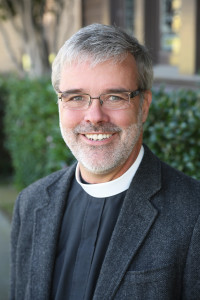
Menu
 The Rev. Dr. Bob Honeychurch, Interim Rector
The Rev. Dr. Bob Honeychurch, Interim Rector
I was speaking with a friend today about the recent storms we had in Santa Barbara this past weekend. Between downpours, he bundled up his two young children, and took them outside to romp in the standing water and the mud. One child immediately took to this new adventure, splashing in the water and sliding around until she was thoroughly soaked and covered in dirt from head to toe. The other child, however, was somewhat more skeptical about this experience, and even with a good deal of coaxing, could only tentatively engage in this exercise which was generally not a part of his normal routine.
The encounter of these two children with this weekend’s mud seemed like a particularly salient illustration of the different ways we might enter into this holy season of Lent. Some of us are ready to plunge headlong into the season, prepared to get down and dirty (as it were) in the spiritual exercises and personal discipline so often associated with Lent. Others, however, are not quite sure what to do with this invitation to engage in this holy work, especially when it is not the type of activity which occupies our time during the rest of the year.
It’s appropriate, I think, that the season of Lent should begin with a day called “Ash Wednesday” – where basic earthly dirt plays such a significant role in the liturgy. We are marked with the ashes of the day on our foreheads, partly to remind us of our mortality, and partly to remind us that playing in the dirt of life is specifically what God invites us to do during this season. For it is in that dirt, and from that dirt – with the reminder that we and the dirt are one, as we hear in the words, “Remember that you are dust, and to dust you shall return” – that new life emerges.
The word “Lent” comes from the old German word meaning “springtime”, as we prepare the soil of our hearts for the new life we await at Easter. So during these days ahead, I invite you to experience the season in all its fullness… by getting dirty (either figuratively or literally) in the business of deepening your faith, of strengthening the bond between yourself and God’s creation, of re-connecting with others in whom the face of God shows forth.
Being a Christian – when we are at our best – is dirty business. So find some dirt. And be some dirt. Experience the new growth that can happen when the ashes of our existence and the waters of our baptism combine to form the stuff of life from which the seeds of life can spring to life.
Learn More
 Steve O’Connor, Director of Music Ministries
Steve O’Connor, Director of Music Ministries
Sometime between the end of Sunday worship on March 2 and sundown Tuesday, March 4 a star will fall at All Saints. Specifically, the large star now positioned above the high altar, placed there for the season of Epiphany, will come down, as we transition into the new season of Lent.
Since January 6, the Feast of the Epiphany, the Church has celebrated the various manifestations, or “epiphanies” of Jesus’ divinity after his birth. These have included the coming of the Magi, Christ’s baptism, the Wedding at Cana where he miraculously changed water into wine, the Presentation of Our Lord in the Temple, also called Candlemas where Christ’s light to the world is symbolically recognized in the blessing of the Church’s candles. During these six weeks of the Season after Epiphany, we like the Wise Men, have followed the star, the “bright light” of Christ, as his divinity has been made known to us.
The Church now transitions into a time of conversion, a season of preparation for the coming Paschal mystery of Christ’s saving death and resurrection. This preparation marks the season of Lent. From the Old English word for “spring” – the time of lengthening days – Lent is a period of forty days (not including Sundays, each of which are “little Easters”), in which we are called to prepare for God’s saving gift of Easter. All Christians are invited, in the words of the Book of Common Prayer, “to the observance of a holy Lent, by self-examination and repentance; by prayer, fasting, and self-denial; and by reading and meditating on God’s holy Word.”
Theologically in Lent, we are reminded of God’s generosity. The Lectionary readings for Lent 1 include the story of Adam and Eve in the Garden of Eden, the Old Testament’s second story of Creation. The first Creation account, creation in six days and “God saw that it was good,” is the opening reading at the Easter Vigil during Holy Week. The four primary scriptural symbols of the season are Bread and Water, Hunger and Thirst, Light and Darkness and Clothing and Nakedness.
Oscar Wilde’s interpretation of Psalm 130 is a fitting reminder of our need for God’s generous abundance:
Out of the depths I cry to thee, O Lord!
Lord, hear my voice!
Let thy ears be attentive to the voice of my supplications!
For with the Lord, there is steadfast love, and with him is plenteous redemption.
And he will redeem Israel from all its iniquities.
As we transition from the season of Epiphany into the season of Lent, you are encouraged to “catch a falling star,” that is, to receive the saving Light of Christ and welcome into your life the abundant gifts of God.
Learn More